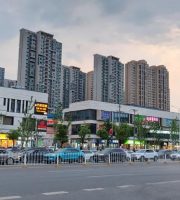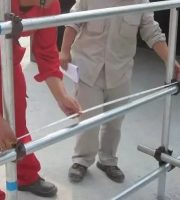With the rapid development of the city, many high-rise buildings have sprung up
.
Large lifting equipment is widely used in the construction field
.
When we undertake many large-scale projects, we will encounter many tower operations
.
In the field construction, safe operation is not only related to the safety of individuals, but also related to the lives of others and the healthy development of enterprises
.
01 operation principle As a group of tower operation, it must be orderly in order to ensure safe and efficient operation
.
The operation principle is as follows: 1
.
Low tower gives way to high tower
.
Low tower should observe the operation of high tower before operation 2
.
When the latter tower gives way to the first tower in the cross area of two tower crane arms, the tower crane that enters the area later will avoid the tower crane that enters the area first
.
3
.
When the operating tower allows the static tower to work in the cross area of two tower crane arms, the operating tower crane should avoid the static tower crane
.
4
.
When the light truck gives way to the heavy truck and the two tower cranes are running at the same time, the no-load tower crane should actively avoid the loaded tower crane
.
When the tower crane is rotating, it is strictly forbidden to carry out the lifting operation at the same place with the adjacent tower crane
.
5
.
The operation of the high tower will stop when the low tower is jacked up
.
High tower jacking, low tower is not allowed to work in the range of high tower jacking
.
02 standardized operation process For the standard operation of group tower operation, in addition to strictly abide by the operation rules, what else should we pay special attention to? A brief summary is as follows: 1
.
Before on-site environmental safety inspection, check the on-site environment to ensure safe operation distance and various safety conditions
.
2
.
The safe distance of group tower crane operation, the distance between the highest position of low tower and the lowest position of high tower shall not be less than 2m
.
The height between the towers must be more than 5m, and there must be enough safety distance between the low tower jib and the high tower body
.
Safe lifting distance: the distance between the lifting height of the hook and the head of the boom shall not be less than 1m
.
When the heavy object is lifted and translated, its height shall not be less than 1m from the object to be crossed
.
For the crane with boom luffing, it is forbidden to hang heavy objects and adjust boom luffing
.
3
.
Before the operation of the device, check whether the limit device and safety device are flexible and reliable
.
Whether the wire rope is worn, whether it is damaged, and whether it needs to be replaced
.
At the beginning of the operation, sound the horn to give a warning
.
4
.
The signal operation driver shall operate according to the signal, semaphore and gesture sent by the signal commander during the operation, and whistle before operation
.
If the signal is not clear or the command is wrong, the driver has the right to refuse to implement and take measures to prevent the accident
.
5
.
Selection and use of lifting rigging tower cranes are not allowed to use the hook to directly lift heavy objects, but must use rigging or special tools
.
The tower crane should reasonably select the sling according to the operation conditions and relevant standards
.
It is strictly forbidden to use different types or models of rigging together
.
6
.
Sequential shift operation
.
Starting from the zero position of dead center, shift by shift operation is strictly prohibited
.
When changing the direction of the transmission device, pull the controller back to the zero position first, and then reverse the operation after the transmission stops
.
It is strictly forbidden to change the direction of operation directly
.
The operation should be smooth
.
7
.
When lifting and balancing slender and loose articles, more than two layers should be tied, and there should be two lifting points; In the process of lifting, keep the lifted objects level and not allowed to deviate, so as to avoid accidents caused by heavy objects being pulled out of the binding due to self weight or vibration
.
When lifting loose and broken articles, they should be filled with nets, baskets or other containers instead of ropes
.
When lifting larger or longer objects, a sliding rope to prevent swing shall be set at both ends of the object to be lifted
.
8
.
There must be enough lighting for night construction, and there must be warning lights on the tower crane
.
9
.
When the tower crane is stopped, the hook and luffing trolley must be received to the specified position
.
When the crane stops work, has a rest or has a power failure, the holding brake shall be relaxed to unload the heavy objects, and the heavy objects shall not be suspended in the air
.
When the tower crane is finished, the driver shall park the crane in a position that does not hinder the rotation
.
For the crane with brake or normally closed brake on the slewing mechanism, the driver must release the brake after stopping the operation, and it is absolutely forbidden to restrict the boom to rotate with the wind
.
Before off duty, the driver must lift the tower crane hook to 3m above the highest obstacle, pull all controllers back to zero after off duty, release the rotary brake, cut off the indoor power supply, make shift handover records, close all doors and windows and lock them, and then cut off the main power switch of power supply after off duty
.
In order to prevent fire and electric shock accidents, safety measures must be taken for the heating of the cab in winter
.
03 “hard” rule of no operation When the alarm goes on, we should adhere to the rule of “ten no hoisting” in hoisting: ① hoisting is not allowed when the command signal is unclear
.
② No hoisting is allowed for cable-stayed and inclined hanging
.
③ It is not allowed to lift the object with unknown weight or overload
.
④ It is not allowed to lift if the loose materials are not tied firmly or the materials are loaded too full
.
⑤ No one is allowed to lift on the object
.
⑥ No lifting is allowed for objects buried underground
.
⑦ Do not lift if the safety device is out of order or sick
.
⑧ The scene is dark and the lifting point of the object is not allowed to be lifted
.
⑨ The edge object is in direct contact with the wire rope, and it is not allowed to lift without protective measures
.
⑩ No hoisting in strong wind above level 6
.
We also add a few points, such as the following situations are also prohibited: ① no operation in strong wind above level 6 and rainy days
.
Special treatment is required for cranes working in rain
.
② It is forbidden to operate after drinking
.
③ It is strictly forbidden for heavy objects to fall freely
.
When the heavy objects fall about 1m away from the positioning point, slow positioning must be adopted
.
④ In case of failure, it is strictly forbidden to repair, adjust and maintain the crane during operation, and live line inspection is not allowed except when necessary
.
The driver must climb up and down the ladder and is not allowed to carry heavy goods
.
04 inspection summary In order to prevent tower group collision, effective measures must be taken from the aspects of tower crane installation, lifting, maintenance and operation
.
These measures must be strictly followed by both the leasing unit and the user
.
In the whole construction process, in addition to control these, we found the following problems: through several items inspected this year, due to the layout of tower crane, the allocation of labor force, and the impact of construction progress, the tower crane originally planned to be attached to the wall for jacking could not complete the jacking plan, as a result, the tower crane could not complete the jacking plan ° Spin
.
In the first case, there is a height difference between the two adjacent buildings of the project, but due to some reason, the high-rise building can not be constructed temporarily, so the positioning of tower crane must be close to the low building
.
After the high building comes up one floor at a time, the tower crane boom of the low building can not reach 360 ° Rotation has the risk of building collision
.
In this case, the flat head tower crane is generally selected to shorten the boom to solve the problem
.
After the boom is retracted, the slewing radius of the tower crane is reduced, the efficiency is reduced, and the safety risk is increased in the process of boom retraction
.
In the second case, if a tower crane only serves this building, the general measure is to strictly disclose to the driver and the commander, hoist within the allowable rotation range, and lock the hook on the fixed building structure before work every day
.
However, this measure is only an expedient measure, and the risk is that the driver’s misoperation lacks protection, In severe convective weather, especially typhoon, it is very dangerous to lock the hook
.
Once the hook is released, the tower crane boom will hit the nearby buildings or scaffolds, causing losses
.
In the third case, if a tower crane wants to serve the adjacent buildings together, the above practice is impractical
.
Generally, the measures are to add a temporary wall, and add a wall below the original wall position to improve the height of the free end to meet the construction requirements
.
The disadvantage of this method is that the number of jacking is increased, and the jacking process wastes time and labor, It reduces the construction efficiency, increases the cost, and increases the risk of safety accidents in the process of jacking.
.


